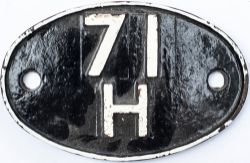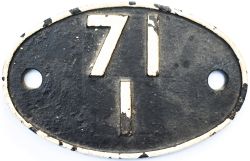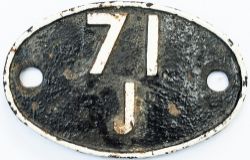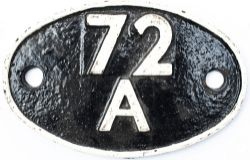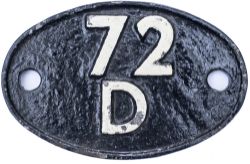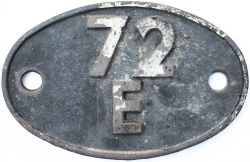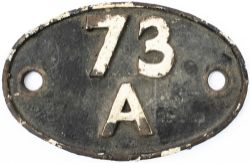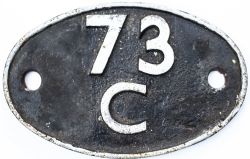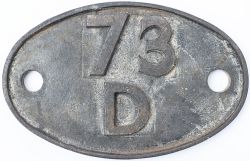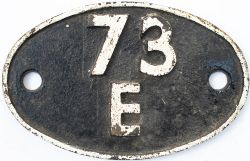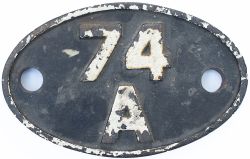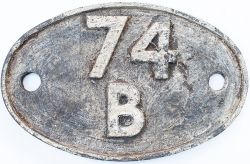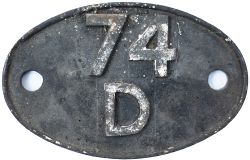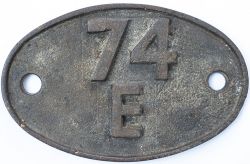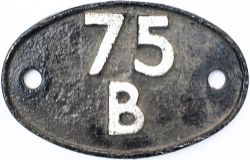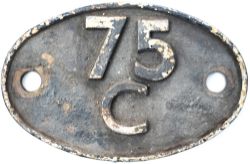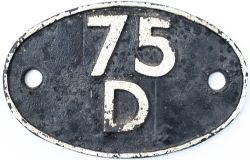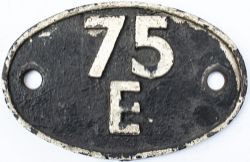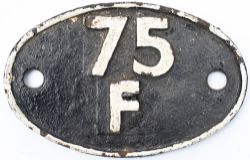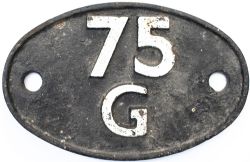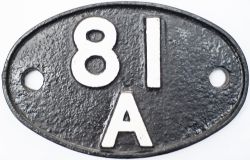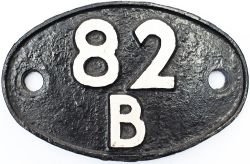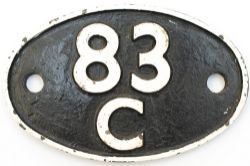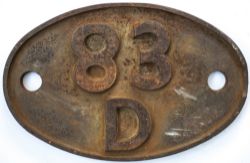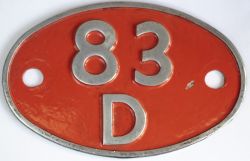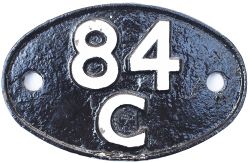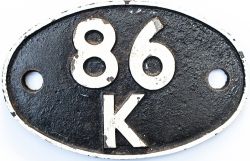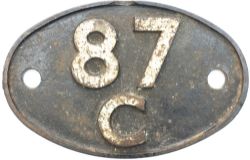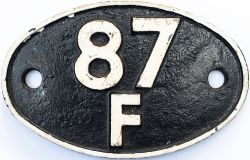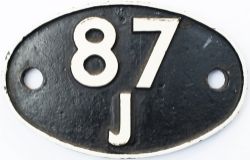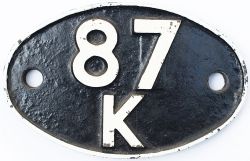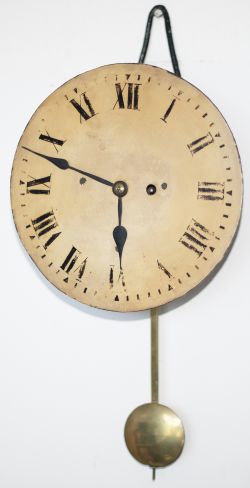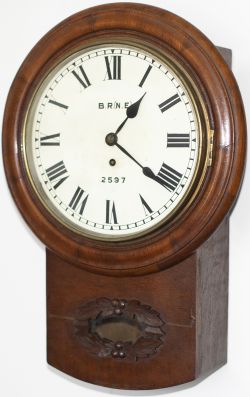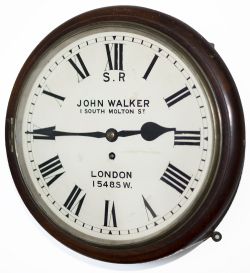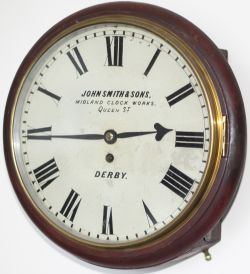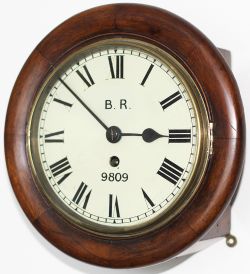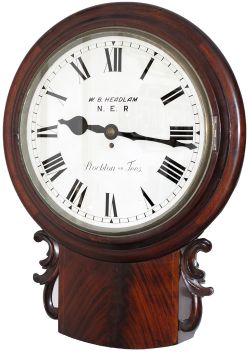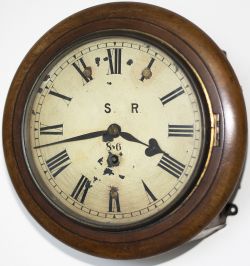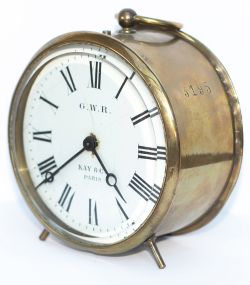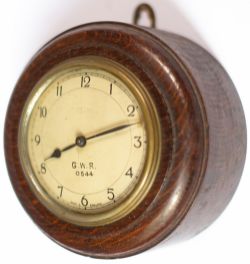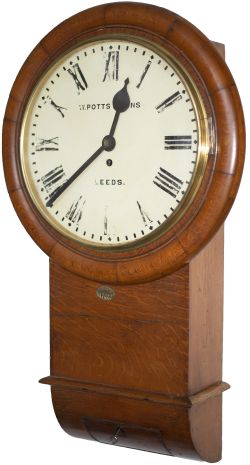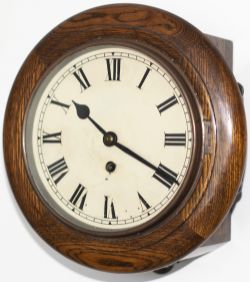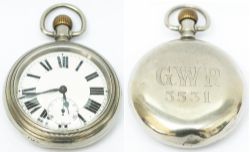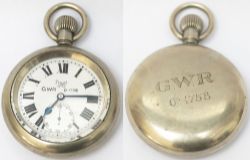You need to be registered and approved to bid at this auction.
Watch the auction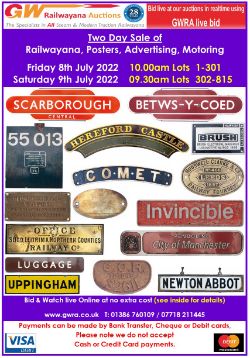
|
Auction currency
|
GBP |
|
Accepted cards for registration
|
|
|
Accepted cards for payment
|
|
|
Other payment methods
|
Shedplate 71B Bournemouth 1950-September 1963. This ex LSWR shed had a good number of Bullied Pacifics in its allocation of around 60 locos, notably 13 West Country and 7 Merchant Navy. It was recoded 70F and finally closed to steam in July 1967. I n restored condition with the BR(S) Eastleigh triangle cast into the back.
Shedplate 71H Templecombe 1950-February 1958, then Yeovil Pen Mill until January 1959. The ex SDJR shed at Templecombe, formerly 22D under LMS ownership, had 17 locos during its period as 71H. When Templecombe moved to the WR, Yeovil Pen Mill a forme r WR shed, took on this SR code. 8 WR Pannier Tanks and 2 45XX 2-6-2T adopted this code for just 11months. When Pen Mill closed they were transferred to Yeovil Town shed. Face restored condition with the BR(S) Eastleigh triangle cast into the back and typical Southern region casting marks on the front.
Shedplate 71I Southampton Docks 1948-September 1963. This ex LSWR shed was perhaps most famous for its allocation of 14 USA tanks. In September 1963 it was recoded 70I, when it had also become home to 14 Class 07 diesel shunters. Face restored condit ion with the BR(S) Eastleigh triangle cast into the back and typical Southern region casting marks on the front.
Shedplate 71J Highbridge 1950 to February 1958. This ex S&DJR shed, formerly 22E in LMS days, was home to just 7 locos during the time it used this code. It then became a sub shed of 82F Bath Green Park, then 82G/83G Templecombe and finally close d in March 1966. Lightly face restored condition with the BR(S) Eastleigh triangle cast into the back.
Shedplate 72A Exmouth Junction 1950- September 1963. This ex LSWR shed to the east of Exeter had over 120 locos allocated throughout this period. At its peak it had 33 Bullied Light Pacifics and 7 Merchant Navies as well as 5 of those exotic Z class 0-8-0 tanks. In September 1963 it received the WR code 83D. Face restored condition with the BR(S) Eastleigh triangle cast into the back and typical Southern region casting marks on the front.
Shedplate 72B Salisbury 1950-December 1962. An allocation of 50 locos, containing 10 Battle of Britains, 3 Merchant Navies and 7 King Arthurs graced this ex LSWR shed in the 1950s. It was recoded 70E in 1962. As removed condition with the BR(S) Eastl eigh triangle cast into the back and typical Southern region casting marks on the front.
Shedplate 72C Yeovil Town 1948 to September 1963. This ex LSWR shed was home to 15 locos during the 1950s. It became then became 83E and closed in June 1965. As removed condition with the BR(S) Eastleigh triangle cast into the back.
Shedplate 72D Plymouth Friary 1948-February 1958. This ex LSWR shed had a small but distinguished allocation of 23 locos in 1950, which included 4 West Countries the two named 0-6-2Ts and 30102 Granville. In 1958 it was transferred to the WR becoming 83H, and closed in May 1963. In face restored condition with typical Southern region casting marks on the front and the BR(S) Eastleigh triangle cast into the back. Vendor states it was removed from O2 class 30225.
Shedplate 72E Barnstaple Junction 1950-December 1962. This ex LSWR shed housed 13 locos. In 1962 it was transferred to the WR and eventually received its new code 83F in September 1963. As removed condition with the BR(S) Eastleigh triangle cast into the back and typical Southern region casting marks on the front.
Shedplate 73A Stewarts Lane 1950-June 1962. This ex SECR shed had an allocation of over 100 locos during this period. Of note were 7 King Arthurs, 6 Schools 13 Bullied Light Pacifics and 3 Merchant Navies. In June 1962 it was recoded 75D, and lost it s steam allocation in September 1963. It is still a Repair and Maintenance depot for diesel and electric locos and a servicing point for steam locos. As removed condition with the BR(S) Eastleigh triangle cast into the back and typical Southern region casting marks on the front.
Shedplate 73B Bricklayers Arms 1948-June 1962. This ex SECR shed had a substantial allocation in the 1950s numbering around 140 locos. It was mostly noted for its allocation of 13 Schools 4-4-0s and a varying number of Light Pacifics. In lightly clea ned condition with the BR(S) Eastleigh triangle cast into the back and typical Southern region casting marks on the front.
Shedplate 73C Hither Green 1948 to October 1961 for steam. This ex SR shed was home to around 50 locos during the 1950s. It became home to Class 24 and 33 diesels, many carrying this type of code. In restored condition with typical Southern region ca sting marks on the front and the BR(S) Eastleigh triangle cast into the back. Vendor states it was removed from W class 31923.
Shedplate 73D Gillingham 1948 to June 1959. This ex SECR shed had an allocation of around 35 locos during the 1950s. It lost its allocation in 1959 but remained a sub shed servicing locos from Tonbridge. It finally closed in June 1960. In lightly cle aned condition with the BR(S) Eastleigh triangle cast into the back and typical Southern region casting marks on the front.
Shedplate 73E Faversham 1948 to June 1959. This ex SECR shed was home to 30 locos during the 1950s. Face restored condition with typical Southern region casting marks on the front.
Shedplate 74A Ashford 1950-October 1958. This ex SR shed had six King Arthurs in an allocation of 60 in 1950. By the time it was recoded 73F in 1958, the total number of locos was down to 40.It finally closed to steam in June 1962. In as removed cond ition this pattern most likely was cast at Ashford not Eastleigh.
Shedplate 74B Ramsgate 1950-October 1958. This ex SR shed had a star studded allocation in the 1950s comprising 8 Schools, 5 West Countries and 11 Battle of Britains. It became 73G in October 1958, and closed to steam in June 1959. In cleaned conditi on with the BR(S) Eastleigh triangle cast into the back.
Shedplate 74C Dover 1950-October 1958, then recoded 73H, closing June 1961. This ex SR shed had an allocation of 70 locos, including 7 King Arthurs, 4 Schools, 4 Battle of Britains, and two Merchant Navy's. In lightly face restored condition with the BR(S) Eastleigh triangle cast into the back and typical Southern region casting marks on the front.
Shedplate 74D Tonbridge 1950 to October 1958. This ex SECR shed had an allocation of 60 locos during the 1950s. As removed condition with the BR(S) Eastleigh triangle cast into the back and typical Southern region casting marks on the front.
Shedplate 74E St. Leonards 1950 to June 1958. This ex LBSCR shed was home to 30 locos which included 11 Schools class 4-4-0s. As removed condition with the BR(S) Eastleigh triangle cast into the back and typical Southern region casting marks on the f ront.
Shedplate 75A Brighton 1950-closed to steam June 1964. This ex LBSCR shed had a 1950s allocation of around 75 locos, most notable being the Brighton Atlantic's and a large number of the Schools 4-4-0s. A handful of West Country Pacifics were also mai ntained here. In restored condition with the BR(S) Eastleigh triangle cast into the back and typical Southern region casting marks on the front.
Shedplate 75B Redhill 1950-May 1965. This ex SECR shed was home to around 25 locos in the 1950s. Its final allocation of 18 BR standard 2-6-4Ts was moved away in early 1965, making this the final Central Division depot to close to steam. In restored condition with the BR(S) Eastleigh triangle cast into the back and typical Southern region casting marks on the front.
Shedplate 75C Norwood Junction 1950-January 1964 to steam, small allocation of diesel shunters until closure in 1966 In early BR days this ex SR shed had 40 locos, which was reduced to 18 in its final year. A small fleet of diesel shunters also carr ied this code; 3 03s, 15 08s and 3 of their SR forerunners. In as removed condition with the BR(S) Eastleigh triangle cast into the back and typical Southern region casting marks on the front and traces of some Yellow paint indicating it may have been fitted to one of the Diesel Shunters.
Shedplate 75D Horsham 1950 to July 1959, then Stewarts Lane June 1962 to September 1963 for steam. This ex LBSCR shed had 15 locos when it lost its code and became a sub shed of Three Bridges and the Brighton. The ex SECR shed at Stewarts Lane had 45 locos when using this code. On becoming a diesel and electric depot, several of its allocation also carried this code. In restored condition with the BR(S) Eastleigh triangle cast into the back and typical Southern region casting marks on the front.
Shedplate 75E Three Bridges 1948 to June 1964. This ex LBSCR shed had 30 locos on its books in the 1950s., which dwindled to just 14 within a few months of closure. As removed condition with the BR(S) Eastleigh triangle cast into the back and typical Southern region casting marks on the front.
Shedplate 75F Tunbridge Wells West 1948-June 1965. This ex LBSCR shed maintained a total of 25 locos in the 1950s, but although losing its allocation in 1963, it went on servicing locos for another two years until final closure in June 1965. In face restored condition with the BR(S) Eastleigh triangle cast into the back and typical Southern region casting marks on the front.
Shedplate 75G Eastbourne 1948- June 1965 Although this ex LBSCR shed remained open for servicing until 1965, it lost its allocation, and therefore its code, as early as September 1952, when the 33 locos there were transferred away. In restored condit ion with the BR(S) Eastleigh triangle cast into the back.
Shedplate 81A Old Oak Common 1949 to March 1965. This ex GWR shed had a star studded allocation of nearly 200 locos in the 1950s, including 8 Counties, 30 Castles, 13 Kings and 37 Halls, making it the largest shed in the Western region. Face restored , rear original with clear Swindon casting marks in the edge and rear.
Shedplate 82B St Philips Marsh 1950 to 6/64. This ex GWR shed in Bristol had a substantial allocation of over 140 locos in the 50s, including a large number of Halls and Granges. Face restored over original paint, rear original with clear Swindon ca sting marks in the edge and rear.
Shedplate 83C Exeter 1949 to October 1963. This ex GWR shed had an allocation of 35 locos during the 1950s, but in the final 18 months of its life, this was down to single figures. Face restored over original paint, rear original with clear Swindon c asting marks in the edge and rear.
Shedplate 83D Plymouth Laira 1949 to September 1963, recoded 84A, closed to steam April 1964. This ex GWR depot had between 80 and 100 locos during the period it used this code. At one time it had 18 Castles, 3 Counties, 1 star, 11 Halls, 2 Granges , 4 Manors and last but not least, 10 Kings. It was also home to Class 41/43 Warships and Class 52 Westerns, many being noted carrying these cast iron steam codes. In face cleaned condition with Swindon U 201 pattern number clearly visible . Note the 8 has been cast upside Down.
Aluminium shedplate 83D Plymouth Laira to September 1963. In face restored condition, these were fitted to the early Western Region hydraulics.
Shedplate 84C Banbury 1949 to September 1963, then Truro September 1963 to November 1965. The ex GWR shed at Banbury housed between 50 and 70 locos during this period, before it was transferred to the LM region, becoming 2D. By the time the ex GWR sh ed at Truro had gained this code, it had lost its steam allocation and was being used as diesel stabling point. Closure came in November 1965. Face restored, rear original with clear Swindon casting marks in the edge and rear.
Shedplate 84G Shrewsbury 1950 to September 1960. The ex GWR/LNWR Joint shed had used 4 different BR codes by the time it closed to steam in November 1967. Formerly LMS 4A, a code which BR used until 1950; it became WR 84G then 89A, and finally 6D on transfer to the LMR in 1963. The late 1950s allocation using this code included 7 Counties, 15 Halls, 4 Castles and a pair of Manors. Face restored, rear original with clear Swindon casting marks in the edge and rear.
Shedplate 86K Abergavenny Brecon Road 1949 to November 1955 then Tredegar November 1955 to June 1960. Ex LNWR shed at Abergavenny had 38 locos in 1950. Ex LNWR Tredegar had just 10 locos when using this code. Face restored, rear original with clear S windon casting marks in the edge and rear.
Shedplate 87C Danygraig 1949 to January 1960 for steam, March 1964 totally. This ex R&SBR shed was home to an exotic collection of pre grouping tank engines throughout it BR days when its total allocation was never more than 30 locos. In lightly cleaned original condition.
Shedplate 87F Llanelly 1949 to October 1965. This ex GWR shed housed 90 locos in the 50s, and during its BR life it had a sprinkling of Halls and Granges. Its final year's allocation of 22 included 3 ex LMS 8F 2-8-0s. Face restored, rear original wit h clear Swindon casting marks in the edge and rear.
Shedplate 87H Neyland 1949 to September 1963, then Whitland until December 1963. The ex GWR shed at Neyland had an allocation of 45 locos which at one time included 4 Counties, 4 Halls and a solitary Manor. On closure, sub shed Whitland used the code for its allocation of 15 locos until it too closed just three months later. Face restored, rear original with clear Swindon casting marks in the edge and rear.
Shedplate 87J Fishguard Goodwick 1949 to September 1963. This ex GWR shed had a small allocation of just 14 locos throughout the 1950s which included the ever present 59xx Halls Knowsley, Moreton and Haddon. Face restored, rear original with clear Sw indon casting marks in the edge and rear.
Shedplate 87K Swansea Victoria 1949 to August 1959. This ex LNWR shed, formally coded 4A by the LMS, became part of the WR in 1949, when it was home to 50 locos. It retained a substantial allocation of 55 locos right up to closure. Face restored, rea r original with clear Swindon casting marks in the edge and rear.
Shedplate 89C Machynlleth 1948 to September 1963. This ex Cambrian Railways shed was home to 50 locos in the 1950s. Recoded 6F in 1963, it closed in December 1966. In as removed condition with clear Swindon casting marks in the edge and rear.
LNER enamel cab shedplate ANNESLEY. Black on white enamel in good condition with some edge chipping. Measures 10in x 1in.
Lancashire and Yorkshire Railway 12 inch mahogany cased fusee railway clock with wire driven English fusee movement with shaped shoulders and ringed pillars, supplied circa 1860-70. The original dial displays BR(NE) 16762 and this would have been app lied in the 1950's when the North Eastern region took over control of the clocks from this area. The case has one side door and a bottom door secured with a brass turn and the back is branded twice L.Y. The LNER clock records show this clock as last being in use at Wakefield Kirkgate West Junction Cabin (Signal Box) and was LMS clock number 9787 it was sent to Collectors Corner Euston for sale in December 1986. In working order but not checked for accuracy complete with pendulum and key. A copy of the clock record accompanies the lot.
Midland Railway 10in fusee signal box clock complete with original tinplate movement cover with BR-W 5645 ivorine numberplate fixed to the top. The original dial is ghosted BR-W and the English wire driven fusee movement has been cleaned and overhaul ed at some point. These clocks were supplied to the Midland Railway Company by Mann of Gloucester and could be found in all of their signal boxes south of Birmingham in Gloucestershire, Worcestershire, The Severn and Wye, and the Somerset and Dorset Railways. The Vendor states that this clock is believed to have originated from Evesham as that's where his father worked on the Railway. In working order but not checked for accuracy complete with pendulum and key.
North Eastern Railway 10 inch oak cased dial clock manufactured for the NER by W.B. Headlam of Stockton On Tees circa 1870. The early English wire driven fusee movement has rectangular plates with shaped shoulders which are held together by turned sh aped pillars, the original enamel painted dial shows BR(NE) 2597 and the case manufactured from fine figured oak with a turned segmented surround lenticle window with an ornate surround and has two side access doors and a bottom door secured by a brass turn and on the inside right door is the original NER clock label with NER Clock No N711. The LNER records show that this clock was last in railway use at Castleton Station masters office and had been transferred from Commondale in March 1959. A nicely proportioned clock. In good working condition complete with pendulum and key and comes with a copy of the LNER clock record.
London and South Western Railway 12 inch dial mahogany cased English fusee railway clock with a cast brass bezel supplied to the LSWR circa 1870 by John walker of London. The English chain driven fusee movement has rectangular plates held together by turned tapered pillars, the original enamel painted shows SR JOHN WALKER 1 SOUTH MOLTON ST LONDON 1548 SW and the case with one side door and a bottom door with lock present but no key now secured with a brass latch. The Southern Railway clock records show that this was supplied by John Walker and was last reordered in railway use at Waterloo Station Engineer Plan Branch Office. In good working condition complete with pendulum and key and comes with a copy of the SR clock record.
Midland Railway mahogany cased 12 inch dial mahogany cased English fusee railway clock supplied circa 1870 by John Smith & Sons of Derby. The English wire driven fusee movement with rectangular plates and turned pillars, the original dial is writ ten John Smith & Sons Midland Clock Works Queen St Derby and has some small areas of restoration, the case has 2 side doors and a bottom door and is in good condition complete with the LMS brass oval numberplate LMS 12000 pinned onto the right hand side. In good working condition complete with pendulum and key and a copy of the British Railways Collectors corner receipt dated 28-07-1990 and states the clock was ex Nottingham.
Great Northern Railway 8 inch Mahogany cased English fusee railway clock, The English wire driven fusee movement with rectangular plates and turned pillars, the original dial is written BR 9809 and the case has one side door and a bottom door secured by a brass turn . The LNER records show that this clock was last in railway use at Horncastle Signal Box. In good working condition complete with pendulum and key and comes with a copy of the LNER clock record.
North Eastern Railway 18 inch mahogany cased drop dial fusee railway clock with a cast brass bezel. and rectangular plated wire driven English fusee movement. The restored dial displays W.B. HEADLAM STOCKTON ON TEES N.E.R. and has BR(E) 13755 pencill ed on the back. The superb mahogany trunk case with carved ears has one side door and a bottom door secured with a brass turn and has 13755 stamped into the back of the case. A huge fusee clock, in Working order but not checked for accuracy complete with pendulum and key.
London and South Western Railway 8 inch dial mahogany cased fusee clock supplied to the LSWR in 1898 by Thomas of Southampton at a cost of 1-16-0. The rectangular plated wire driven fusee movement has turned screwed pillars. The mahogany case has a o ne piece turned surround, dovetailed back box with one side door and a bottom door with cock beading secured by a brass lock no key present, it has also lost some veneer at the bottom. The original dial is lettered L.S.W.R 86 although the L and W have been rubbed out in Southern Railway days but are clearly visible. The Southern Railway clock records show this clock as last being in use at Redbridge Permanent Way Engineers. In working condition complete with pendulum and key. A rare clock that has retained its pre grouping dial writing albeit with the L and W visible as ghosted writing. In working condition complete with pendulum, key and a copy of the clock record, but not tested for timekeeping.
Midland Railway 12in fusee oak cased railway clock supplied by Mann of Gloucester circa 1870. The chain driven English fusee movement with large A frame plates is in clean condition and the Oak case with two side doors and a bottom door is in good co ndition with the LMS clock numberplate LMS 13436 pinned to the right hand side. The original dial displays MANN GLOUCSTER. Mann supplied clocks to the Midland Railway Company for the area including Gloucestershire, Worcestershire, The Severn and Wye, and the Somerset and Dorset Railways. In working condition but not checked for accuracy complete with pendulum and key.
GWR brass drum clock with original enamel dial GWR KAY & CO PARIS. Stamped 3195 on the case, movement and back. The French movement with key wind is in working condition. Dial measures 3.25in diameter and has a few hairline cracks and a small are a of restoration by the 2 o'clock marker. The back of the case is engraved lightly with Ross South Box.
GWR post grouping oak cased Pork Pie wall clock with an English Smiths going barrel movement and dial marked GWR 0544. Measures 6in diameter overall and is in good working condition having just been oiled.
Midland Railway mahogany cased 14in drop dial trunk fusee clock by W. Potts of Leeds circa 1880. The English chain driven fusee movement with rectangular plates and turned pillars has been recently been overhauled. The oak trunk case with two side do ors and the botton door with brass lock is in excellent condition complete with LMS brass oval numberplate 17809. The clock comes with its British Railways Collectors corner receipt dated 16-07-1990 which states the clock was ex Langwathby which was a station on the Settle and Carlisle line. A lovely clock in full working condition, with pendulum and key, ready to hang.
British Railways Southern Region 8 inch oak cased fusee railway clock with a rectangular plated wire driven English fusee movement, supplied to the Southern region in 1959 by Stockall, Marples & Co at a cost of 11-5-0d. The original dial displays in ghosted writing BR(S) 11651 and the case has one side door and a bottom door secured with a brass turn. In working order but not checked for accuracy complete with pendulum and key. The SR clock records show this clock as last in use at Woking Signal Engineer's Work Study Unit. A copy of the Southern Railway clock record accompanies the lot.
London & South Western Railway 8 inch oak cased fusee railway clock with a spun brass bezel and a rectangular plated wire driven English fusee movement. Supplied to the LSWR in the late 19th century by John Walker London. The original dial displa ys JOHN WALKER 1 SOUTH MOLTON ST LONDON 460 W and BR(S) visible at the top ghosted. The case has one side door and a bottom door secured with a brass turn and is stamped in the back box 460 W. The SR clock records show this clock as last in use at Guilford Yard Foreman's Office and previously at Exeter as a relief clock which is when it was numbered with a W suffix. In working order but not checked for accuracy complete with pendulum and key.
Great Western Railway Brass drum railway clock with 3.5 inch enamelled dial GWR J.M. SKARRATT & CIE PARIS. Case engraved with the number 1716 and movement has the GWR modified winder fitted. In good working condition complete with a newly fitted quality Swiss platform escapement. These pre date the Kays version and are much rarer.
GWR oak cased PORK PIE signal box clock. The quality French made movement has been recently oiled and fitted with a new platform escapement, the enamel dial is hand painted GWR 0.35 has a couple of small chips on the edge. These are a superior clock to the later Smiths type. Measures 6.5in diameter and in working condition but not tested for accuracy.
Great Western Railway pre grouping nickel cased pocket watch with a Swiss movement, top wound and top set. The dial has a couple of hairlines. The rear of the case is hand engraved GWR 3531. In working condition, but not tested for accuracy.
Great Western Railway post grouping nickel cased pocket watch No 0.1758. With a Limit No2 Swiss made 15 jewel movement top wound and top set. Dial has GWR 03262 painted on and is free from cracks and chips. Rear of the case is hand engraved G.W.R. 0. 1758. In excellent working condition.
Confirming your bid is a legally binding obligation to purchase and pay for the lot should your bid be successful.
Confirming your bid is a legally binding obligation to purchase and pay for the lot should your bid be successful.

